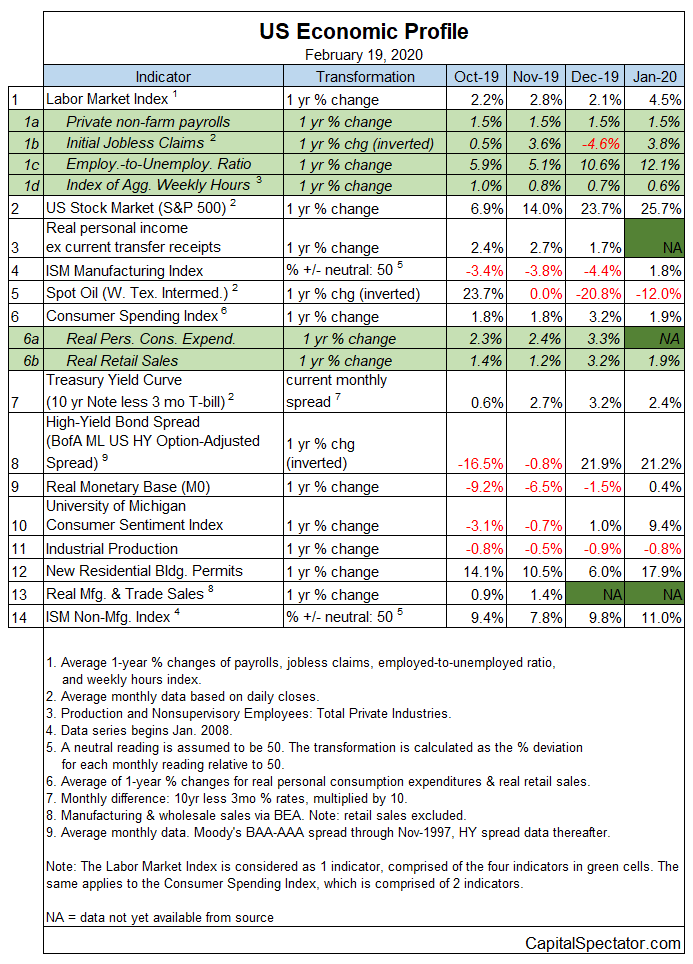The US economy’s slowdown in the second half of last year continues to show signs of mildly rebounding in early 2020 but a preliminary estimate for March suggests the revival is fading. There’s still no sign that recession risk is elevated, based on data published to date. Yet the revised outlook through next month (see third chart below) points to stabilization at a moderate pace of growth rather than a continuation of the recent rebound following a softer macro trend in late-2019.
The reason that the recent upturn in economic activity has faded is debatable, but an obvious culprit is the blowback from the spreading coronavirus that’s slowed China’s economy. The global economy is starting to feel the pinch from this outbreak. America is relatively immune from the economic impact, although estimating the price tag is a work in progress. In any case, a softer outlook for growth on a global basis in the near term appears to be impacting the US, albeit on the margins at this point.
The good news: the macro trend in America continues to reflect a moderate bias for growth at a pace that’s a bit firmer relative the weakest period in last year’s fourth quarter. The analysis is based on published data that tracks the economy through January, as shown in the table below.

Aggregating the data in the table above via a pair of proprietary business-cycle benchmarks shows a moderate revival in the macro trend through last month. The Economic Momentum Index (EMI) and the Economic Trend Index (ETI) continued to rise in January after an extended slide throughout much of 2019. Although both benchmarks have declined substantially relative to recent history, the latest numbers continue to suggest that the slide is over. As noted, however, it also appears that the rebound is giving way to a holding pattern in the projection for March. In any case, ETI and EMI remain well above their respective tipping points that mark recession (50% for ETI and 0% for EMI). Near-term projections for ETI and EMI suggest that these indicators will continue to reflect a moderate growth bias through March. (For details on the design and interpretation of ETI and EMI, see my book on monitoring the business cycle.)

The main takeaway: recession risk was low through January and will likely remain so in the February and March profiles. The methodology is based on translating ETI’s historical values into recession-risk probabilities with a probit model. Analysis through this lens indicates a roughly 1% probability that NBER will eventually declare January as the start of a new recession.

Let’s turn to the near-term future and consider how ETI may evolve as new data is published. One way to project values for this index is with an econometric technique known as an autoregressive integrated moving average (ARIMA) model, based on default calculations via the “forecast” package in R. The ARIMA model calculates the missing data points for each indicator for each month — in this case through March 2020. (Note that November 2019 is currently the latest month with a complete set of published data for ETI.) Based on today’s projections, ETI is expected to rise slightly during the December-through-February period and hold steady in March (see chart below). As a result, today’s estimates suggest that the economic trend is stabilizing well above the critical 50% mark. A reading below 50% would indicate that NBER is likely to declare a month as the start of a recession.

Forecasts are always suspect, but recent projections of ETI for the near-term future have proven to be reliable guesstimates vs. the full set of published numbers that followed. That’s not surprising, given ETI’s design to capture the broad trend based across multiple indicators. Predicting individual components in isolation, by contrast, is subject to greater uncertainty. The assumption here is that while any one forecast for a given indicator will likely be wrong, the errors may cancel out to some degree by aggregating a broad set of predictions. That’s a reasonable view, based on the generally accurate historical record for the ETI forecasts in recent years.
The current projections (the four black dots in the chart immediately above) suggest that the economy will continue to expand through next month, albeit at a relatively moderate pace. The chart also shows the range of vintage ETI projections published on these pages in previous months (blue bars), which you can compare with the actual data (red dots) that followed, based on the current list of published numbers.
For more perspective on the track record of the ETI forecasts, here are the vintage projections for the past three months:
Note: ETI is a diffusion index (i.e., an index that tracks the proportion of components with positive values) for the 14 leading/coincident indicators listed in the table above. ETI values reflect the 3-month average of the transformation rules defined in the table. EMI measures the same set of indicators/transformation rules based on the 3-month average of the median monthly percentage change for the 14 indicators. For purposes of filling in the missing data points in recent history and projecting ETI and EMI values, the missing data points are estimated with an ARIMA model.
